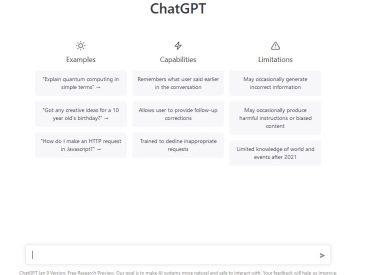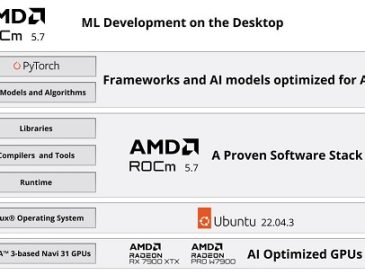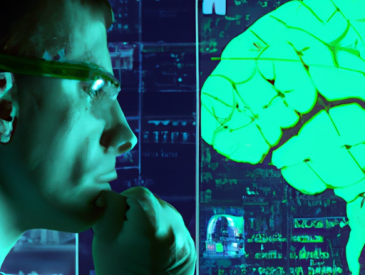What once seemed a distant future is now present in the palm of our hands. We are talking about artificial intelligence ! It already exists and is a part of our lives more than you might think, although it still isn’t the fuel of super-advanced androids.
While large corporations are constantly releasing new technology and you can enjoy them at home or with your smartphone, many people believe that artificial intelligence (AI) still belongs to the universe of science fiction and computing .
In this article, we have brought you a complete guide to everything you need to know about artificial intelligence . Keep reading and find out more!
What is artificial intelligence?
Artificial intelligence is a branch of science and information technology that aims to create intelligent machines . It proposes to develop machines that have the ability to think and act like human beings, not necessarily with a “physical body”.
The concept of artificial intelligence also includes software that can abstract, create, deduce and even learn certain ideas . Currently, the objective of this type of technology is to facilitate day-to-day tasks, modernize industrial processes and obtain advances in scientific research using a more advanced and efficient artificial “brain”.
History of artificial intelligence
The history of artificial intelligence is older than you might think. The term emerged in the 1950s, more precisely in 1956. However, it has only become popular nowadays due to the growth in the availability of data, algorithms and, mainly, in the processing power and storage of computers .
The first works with this type of technology were fundamental to pave the way for automation and reasoning existing in computers today. This path also includes several possibilities for developing systems that provide decision support and intelligent research systems , with the objective of expanding the capabilities of the human intellect.
The first research involving artificial intelligence began in the 1950s, exploring topics such as mathematical problem solving and symbolic methodologies. In the following decade, the US Department of Defense began to take an interest in this type of technological advance and began training computers with the aim of reproducing basic lines of human reasoning.
In 1958, the Defense Advanced Research Projects Agency ( DARPA ) was created, founded by American researchers and military personnel. In the 1970s DARPA was responsible for completing a street mapping project, for example.
The agency also developed the first intelligent personal assistants in 2003 , well before the emergence of this type of technology, now present in smartphones, such as Siri, Cortana and Google Assistant.
The evolution of AI
The main names at the beginning of the development of AI were, without a doubt, those of Herbert Simon , John McCarthy and Allen Newell , who had as a common goal the creation of an artificial being that could simulate human life.
Newell and Simon were responsible for the development of the General Problem Solver ( GPS ), or General Problem Solver. It was a program created to imitate some protocols adopted by humans to solve problems, very advanced if we take into account the limitation of the technology of the time.
As early as 1959, Newell and Simon founded the first AI laboratory, at Carnegie Mellon University in Pennsylvania. In the same year, McCarthy and Marvin Minsky were responsible for founding the MIT AI Lab .
In a historical review, it is possible to observe the existence of two main styles in artificial intelligence research : AI “ neats ” and AI “ scruffies ”. The first refers to the “clean and classic” study of AI involving the use and manipulation of more abstract symbols and concepts, being used in most expert systems, which are programs that seek to solve complex problems in an identical way to human experts.
In turn, the “scruffies” or “ connectionist ” approach has neural networks as its main example. It seeks to create systems capable of becoming intelligent through learning and not through the specific programming of an activity. This approach was completely sidelined in the 1960s and 1970s, but connectionists returned to the scene in the 1980s.
Since then, investment in AI research has grown substantially, mainly due to the contribution made by DARPA in the United States. In addition to this body, Japan has also advanced a lot in the field, mainly with the Fifth Generation Project.
The projects did not present practical and immediate results, which frustrated the expectations of many people and government agencies. This led to funding being cut, greatly reducing AI research . This has made most researchers look for related areas such as robotics and machine learning . Even so, some research into pure artificial intelligence continued, at modest levels.
AI Companies
There are many companies that are pushing the boundaries of AI. Some of them include Google, Microsoft, IBM, Intel, NVIDIA, OpenAI and Amazon Web Services. These companies are developing a range of products and research initiatives related to AI, such as natural language processing, computer vision and machine learning algorithms. Other companies focusing on AI include Salesforce, Apple and Facebook. These organizations are using AI for a variety of applications related to marketing, customer service and personalization. Additionally, startups like Sentient Technologies and Vicarious AI have focused on developing advanced artificial intelligence technologies for autonomous systems, robotics and other applications.
Google is one of the leading players in AI, with a wide range of products and research initiatives related to AI. Google has numerous projects that focus on natural language processing, computer vision, and machine learning algorithms. Google’s DeepMind project is a leading example of this type of research, as they have created an AI system that can play strategy games such as Go and Chess at a superhuman level. Google’s TensorFlow project is another example of their work in AI, as it provides open-source software for developing sophisticated neural networks. Additionally, Google Brain is an AI research project where scientists are exploring how neural networks can gain intelligence. They are also looking into areas like machine learning algorithms, computer vision, and natural language processing. Google also has data centers located around the world to support their research in AI technologies.
Google is also collaborating with universities and other institutions around the world in their research of AI technologies. For example, they have partnered with Stanford University’s Artificial Intelligence Laboratory to develop deep learning algorithms to improve the accuracy of medical diagnoses. Other collaborations include partnerships with UC Berkeley’s Center for Human-Compatible Artificial Intelligence and the Massachusetts Institute of Technology (MIT) Media Lab. Google has also invested in startups that focus on using AI to solve real-world problems, such as health care and environmental protection. In addition, Google is investing heavily in its own research initiatives, such as Google Brain, which allows researchers to conduct experiments on large datasets of data generated by its users worldwide. Finally, Google has made numerous acquisitions related to artificial intelligence, such as DeepMind AI and Vision Factory Technologies.
Microsoft
Microsoft is one of the major players in AI, with a wide range of products and research initiatives related to AI. Microsoft has been working on various AI-related projects, such as its Cortana Virtual Assistant, Bing search engine and HoloLens augmented reality goggles. Additionally, Microsoft has launched its own deep learning platform called Cognitive Toolkit (CNTK) and is collaborating with leading universities around the world to further their research in AI technologies. Microsoft has also acquired several companies focused on machine learning, computer vision and natural language processing such as Swiftkey and Maluuba. Finally, Microsoft is investing heavily in its own research initiatives such as Project Adam and the Image Parser Toolbox that are aimed at advancing AI development.
Microsoft is also a key player in AI research and development. Microsoft has created an AI platform called Azure that provides patterns and services to developers to create intelligent applications. This can be used for tasks such as image recognition, natural language understanding, and deep learning algorithms. Additionally, Microsoft has its own intelligence efforts dedicated to building tools for developers to enable them to use AI more effectively. These include the Microsoft Cognitive Services which allow developers to build intelligent apps with pre-trained APIs from Microsoft and other partners. Furthermore, Microsoft Research is the company’s internal research division which is focused on developing new technology related to AI. The team works on topics such as computer vision, natural language processing, robotics, augmented reality, and machine learning algorithms. Microsoft also works with academic partners around the world on projects related to artificial intelligence and holds annual events dedicated to these topics such as “Microsoft AI Conference” and “the NeurIPS Workshop on Machine Learning Theory & Applications”. Finally, Microsoft has acquired several companies related to Artificial Intelligence such as Bonsai AI, Maluuba Technologies, Genee Solutions Inc., SwiftKeyAI Ltd., Lobe Inc., Semantic Machines Inc., and XOXCO Inc.
OpenAI
OpenAI is a non-profit research laboratory focusing on artificial intelligence (AI). Founded in 2015 by Elon Musk and other noted experts, OpenAI’s mission is to create safe and beneficial AI technologies that benefit humanity. OpenAI’s efforts are focused on advancing the field of AI and creating systems that can learn for themselves without needing to be explicitly programmed. Through their work, OpenAI is leading the way in creating more powerful, reliable and responsible artificial intelligence technology. With its cutting-edge research and groundbreaking initiatives, OpenAI has become one of the most important players in the field of AI. By pushing the boundaries of what AI can do, OpenAI is helping to make sure that this technology is used in a responsible way that benefits humanity as a whole.
OpenAI has conducted a number of research projects and initiatives to advance the field of AI. In 2016, OpenAI released a series of benchmarking tasks for machine learning called “Unsupervised Image Recognition”. This benchmark task sought to measure the performance of AI models trained in an unsupervised fashion with data that had not been previously labeled. Similarly, OpenAI has also worked on reinforcement learning which is how agents learn by receiving rewards or punishments based on their actions. Other projects include Generative Pre-trained Transformer (GPT-3), an unsupervised language model capable of producing human-like text from scratch, as well as OpenAI Gym, a toolkit for training reinforcement learning algorithms. In addition to these research efforts, OpenAI also promotes responsible AI ethics and safety through their work with the Partnership for AI.
Intel
Intel is a major player in AI research and development. Intel has committed significant resources over the years towards artificial intelligence, with investments in technologies such as computer vision, natural language processing, robotics, and machine learning algorithms. Intel’s AI strategy involves developing both hardware and software solutions that are designed to enable developers to deploy AI applications more quickly and accurately. Intel has developed its own hardware for AI tasks such as its Xeon Scalable processors which feature an integrated accelerator for AI workloads. Additionally, Intel offers its Neural Compute Stick which is an all-in-one deep learning development platform that allows developers to create complex machine learning projects on their own desktops or laptops without a powerful GPU. Software wise, Intel has developed OpenVINO which is a toolkit of optimized libraries, toolsets and frameworks designed to simplify the deployment of computer vision models across multiple platforms. Furthermore, Intel also collaborates with leading universities around the world on projects related to Artificial Intelligence and organizes events focused on these topics such as “Improving energy efficiency for deep learning” and “The Future of Autonomous Machines”.
Intel also works with leading companies in the AI space, such as Microsoft and DeepMind on projects related to artificial intelligence. Additionally, Intel has acquired a number of AI-related companies such as Movidius, Nervana Systems, Vertex.AI and Itseez Inc., each of which have become valuable business units within the company. Intel’s development teams are working hard to bring new products to market that make use of AI technology and help make processes more efficient. One example is their Terascale Project which seeks to build highly efficient FPGAs for deep learning applications. Additionally, Intel has launched its own AI accelerator called the Nervana Neural Network Processor (NNP) designed to assist with deep learning tasks such as image recognition and natural language processing. Finally, Intel hosts several conferences throughout the year dedicated towards topics in Artificial Intelligence such as “Intel Artificial Intelligence Day” which aims to bring together industry leaders and academia in order to discuss new developments in this field.
IBM
IBM has been an early innovator in the Artificial Intelligence space, having first developed its AI platform “Watson” over a decade ago. Watson was designed to use natural language processing and machine learning algorithms in order to better comprehend and respond to user requests. Since then, IBM’s AI research team has steadily grown and expanded their capabilities. Today, they are a leader in AI research, offering both hardware and software solutions. For hardware, IBM offers several products such as their Power9-based servers specifically designed for Enterprise AI workloads. Additionally, they also offer several software toolsets such as their recently released “AI OpenScale” which is a platform used by developers to manage and deploy AI models within their organization. IBM also works with some of the leading companies in the industry on projects related to Artificial Intelligence such as Google and Microsoft. Finally, IBM hosts several events throughout the year dedicated towards topics in artificial intelligence such as “IBM World of Watson” which seeks to bring together industry leaders and experts from around the globe to discuss breakthroughs in AI technology.
IBM has worked with various companies and organizations to develop groundbreaking AI solutions such as IBM Watson, IBM PowerAI, IBM Cloud and IBM Watson Studio. As part of Watson, IBM has implemented a range of machine learning algorithms in order to better understand user requests. Additionally, IBM PowerAI is a deep learning software platform designed to make training and running AI models more efficient. For cloud-based AI solutions, IBM offers their Watson Studio which allows users to deploy and manage AI models on the cloud. Last but not least, IBM hosts several conferences dedicated towards topics in Artificial Intelligence such as “IBM Think Conference” which provides attendees with an opportunity to discuss developments in this field.
NVIDIA
NVIDIA is another major player in the Artificial Intelligence space, having released their CoreAI platform in 2018. CoreAI is a hardware and software solution that enables developers to quickly and easily develop AI-based applications. NVIDIA also offers several other products for AI development such as the Jetson SDK which provides developers with access to GPU-accelerated libraries for deep learning algorithms. Additionally, NVIDIA recently released its TensorRT platform which can optimize trained neural network models for deployment on embedded devices and data centers. NVIDIA frequently hosts conferences dedicated towards topics in Artificial Intelligence such as the “GPU Technology Conference” which allows attendees to learn about new advances in this field.
NVIDIA has also been heavily involved in the research side of Artificial Intelligence through collaborations with universities, organizations and companies worldwide. For instance, the company has partnered with MIT to collaborate on developing new frameworks for AI such as computer vision and natural language processing. Additionally, NVIDIA has developed its own open-source deep learning platform called TensorFlow which helps developers create AI models faster and more efficiently. Finally, NVIDIA provides resources such as online courses, tutorials and webinars that allow users to learn more about AI development and how to use NVIDIA’s tools.
Amazon Web Service
How does artificial intelligence work?
As the name implies, AI aims to simulate a very specific human characteristic: intelligence. Its focus is on developing systems that can perfectly simulate human reasoning . More than following programming lines, AI seeks to create machines that can adapt, learn and perform tasks like people.
However, simulating the conditions of the human mind turned out to be a much more difficult task than he had imagined at the beginning of his studies. This is largely due to the difficulty of understanding and functioning of all the biological processes that take place in a human brain.
Thus, artificial intelligence currently works through processes that involve much more than is possible to accomplish in our day-to-day experiences. It is done by code and programming that works through mathematical functions.
In general, the idea is to have a function in which, when you enter a certain value, another value appears. The important thing is to understand that these values are not random, but have a meaning and therefore a function. Likewise, computer codes are not random either, each of which plays a role in the system. Read more about Artificial Intelligence here at www.wickedsciences.com






[…] Language Processing (NLP) is a way of applying computer science to the field of linguistics and artificial intelligence. It focuses on the use of computers to process large amounts of natural language data. This is done […]